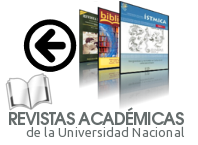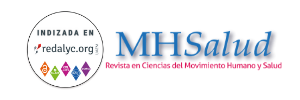Understanding the effects of confinement on movement behaviors in Salvadoran children
DOI:
https://doi.org/10.15359/22.1.18179Keywords:
COVID-19, childhood, physical activity, physical education, quality of lifeAbstract
The problem of sedentary lifestyle in childhood is a public health problem, which is suspected to have been aggravated by the health situation, so understanding the changes in physical activity during confinement in Salvadoran children is of vital importance. This study was qualitative, with an intentional sample, made up of 5 boys and 6 girls between 7 and 10 years old from a private urban school in the Salvadoran capital. The focused interview, with an open-ended questionnaire, was the technique used. The information was analyzed with the triangulation method, using the categories of analysis of the interpersonal, intrapersonal and organizational level. The main findings showed a perception of the infants of decreased physical activity, evidencing the lack of parental support towards active behaviors, which contributed to feelings of loneliness. Social interaction was reduced to family contact, accompanied by the unlimited use of technologies, causing perceptions of isolation and loneliness. Evidently, this study has shown the negative effect of confinement on the physical and mental health of the participants.
References
Álvarez Bogantes, C., Herrera-Monge, M., Herrera-González, E., & Araya-Vargas, G. (2021). Investigation of Variables that Determine Levels of Self-Esteem in Central American Schoolchildren: A Binary Logistic Regression Model. MHSalud: Revista En Ciencias Del Movimiento Humano Y Salud, 18(2), 1-12. https://doi.org/10.15359/mhs.18-2.2
Álvarez, C., y Zelaya, C. (2021). Percepción acerca de las barreras para realizar actividad física en los recreos de los estudiantes de primaria de escuelas públicas de San Pedro Sula. Revista Paradigmas (Manuscrito en proceso de publicación).
Bandura A. (2001). Social cognitive theory: an agentic perspective. Annual Review of Psychology 52:1-26 https://doi.org/10.1146/annurev.psych.52.1.1
Bates, L., Zieff, G., Stanford, K., Moore, J., Kerr, Z., Hanson, E., Barone Gibbs, B., Kline, C., & Stoner, L. (2020). COVID-19 Impact on Behaviors across the 24-Hour Day in Children and Adolescents: Physical Activity, Sedentary Behavior, and Sleep. Children, 7(9), 138. https://doi.org/10.3390/children7090138
Beets, M. W., Cardinal, B. J. & Alderman, B. L. (2010). Parental social support and the physical activity-relatedbehaviors of youth: A review. Health Education & Behavior, 37(5), 621-644. https://doi.org/10.1177%2F1090198110363884
Bjorklund, A., & Salvanes, K. G. (2011). Education and Family Background: Mechanisms and Policies. EconPapers, 3, 201-247. Recuperado el 14 de junio de 2021, de https://EconPapers.repec.org/RePEc:eee:educhp:3-03
Bonal, X. (2014). Cambiar la escuela, la coeducación en el patio de juegos. Barcelona: Universitat Autònoma, Institut de Ciències de l’Educació.
Bourdieu, P. (1991). El sentido práctico. México: Taurus.
Calvano, C., Engelke, L., Di Bella, J., Kindermann, J., Renneberg, B., & Winter, S. M. (2021). Families in the COVID-19 pandemic: parental stress, parent mental health and the occurrence of adverse childhood experiences-results of a representative survey in Germany. European Child and Adolescent Psychiatry, 31,1043-1055. https://doi.org/10.1007/s00787-021-01739-0
Cifuentes-Faura, J. (20 de abril de 2020). Crise do coronavírus: impactos e medidas econômicas na Europa e nos mundos. Espaço e Economia, 9(18), 1-8 https://doi.org/10.4000/espacoeconomia.12874
Davison, K. K., Jurkowski, J. M., Li, K., Kranz, S., & Lawson, H. A. (2013). A childhood obesity intervention developed by families for families: Results from a pilot study. The International Journal of Behavioral Nutrition and Physical Activity, 10, Article 3. https://doi.org/10.1186/1479-5868-10-3
Galoustian, G. (2020). Unintended consequence of covid-19: Cyberbullying could increase. Florida Atlantic University.
Gutiérrez, C. L., & Pérez, C. (2002). El espacio como elemento facilitador del aprendizaje. Una experiencia en la formación inicial del profesorado. Pulso, 25, 133-146. https://doi.org/10.58265/pulso.4894
Haug, E., Torsheim, T., Sallis, J. F., & Samdal, O. (2010). The characteristics of the outdoor school environment associated with physical activity. Health Education Research, 25(2), 248-256. https://doi.org/10.1093/her/cyn050
Ickes, M. J., Erwin, H., & Beighle, A. (2013). Systematic review of recess interventions to increase physical activity. Journal of Physical Activity and Health, 10(6), 910-926. https://doi.org/10.1123/jpah.10.6.910
Ishii, K., Shibata, A., Sato, M., & Oka, K. (2014). Recess physical activity and perceived school environment among elementary school children. International Journal of Environmental. Research and Public Health, 11(7), 7195-7206. https://doi.org/10.3390/ijerph110707195
Jarvis, J. W., Harrington, D. W., & Manson, H. (2017). Exploring parent-reported barriers to supporting their child’s health behaviors: A cross-sectional study. The International Journal of Behavioral Nutrition and Physical Activity, 14, Article 77. https://doi.org/10.1186/s12966-017-0508-9
Jiménez-Pavón D., Carbonell-Baeza A., Lavie, C. J. (2020). Physical exercise as therapy to fight against the mental and physical consequences of COVID-19 quarantine: special focus in older people. Progress in cardiovascular diseases, 63(3), 386. https://doi.org/10.1016/j.pcad.2020.03.009
Lake, A., & Townsend, T. (2006). Obesogenic environments: exploring the built and food environments. J R Soc Promot Health Nov, 126(6): 262-7. https://doi.org/10.1177/1466424006070487
Lanigan, J., Barber, S., & Singhal, A. (2010). Prevention of obesity in preschool children. Proceedings of the Nutrition Society, 69(2), 204-210. https://doi.org/10.1017/S0029665110000029
Leblanc, A. G., Spence, J. C., Carson, V., Connor Gorber, S., Dillman, C., Janssen, I., … Tremblay, M. S. (2012). Systematic review of sedentary behaviour and health indicators in the early years (aged 0-4 years). Applied Physiology, Nutrition, and Metabolism, 37(4), 753-772. http://dx.doi.org/10.1139/h2012-063
Leonardelli, E., Vernengo, M., Wainer, M. y Duhalde, C. (2009). Desarrollo de un modelo para la observación sistemática de situaciones interactivas lúdicas madre-niño. I Congreso Internacional de Investigación y Práctica Profesional en Psicología XVI Jornadas de Investigación Quinto Encuentro de Investigadores en Psicología del MERCOSUR. Congreso desarrollado en la Facultad de Psicología de la Universidad de Buenos Aires, Buenos Aires, Argentina.
Lox, C., Martin, K. & Petruzzello, S. (2010). The psychology of exercise. (3rd Ed). Holcomb Hathaway.
Montil, M. (2004) Determinantes de la conducta de actividad física en población infantil (Tesis doctoral). Universidad Politécnica de Madrid.
Okuda, M. & Gómez-Restrepo, C. (2005). Métodos en investigación cualitativa: triangulación. Revista Colombiana de Psiquiatría, 34(1), 118-124.
Pantoja Vallejo, A., & Montijano González, J. (2012). Study of Healthy Physical Activity Habits in Children in Primary Education in the City of Jaén. Apunts. Educación Física y Deportes, 107, 13-23. https://dx.doi.org/10.5672/apunts.2014-0983.es.(2012/1).107.01
Parrish, A. M., Yeatman, H., Iverson, D., & Russell, K. (28 de junio de 2012). Using interviews and peer pairs to better understand how school environments affect young children's playground physical activity levels: a qualitative study. Health Educ Res, 27(2), 270-280. https://doi.org/10.1093/her/cyr049
Patton, M. Q. (2002). Qualitative Research & Evaluation Methods. Thousand Oaks, California, Estados Unidos: Sage Publications, Inc.
Peterson, M., Lawman, H., Fairchild, A., Wilson, D. & Horn, L. (2013). The association of self-efficacy and parent social support on physical activity in male and female adolescents. Health Psychology, 32(6), 666-664. https://doi.org/10.1037%2Fa0029129
Pinheiro, M. (2012). El jugar de los niños en espacios públicos. (Tesis doctoral). Universidad de Barcelona.
Pitney, W. A., & Parker, J. (2009). Qualitative Research in Physical Activity and the Health Professions. DeKalb, Illinois, Estados Unidos: Human Kinetics.
Pugliese, J., & Tinsley, B. (2007). Parental socialization of child and adolescent physical activity: a meta-analysis. Journal of family psychology, 21(3), 331. https://doi.org/10.1037/0893-3200.21.3.331
Ramírez, I., y González, D. (4 de noviembre de 2020). Del recreo a la soledad: las secuelas emocionales de los niños que se quedaron sin colegio. Saludconlupa. https://saludconlupa.com/
Reyes, R., Otero., E., Pastrán, R., Herrera-Monge, M., & Álvarez, C. (2018). Análisis del sobrepeso, obesidad, niveles de actividad física y autoestima de la niñez de León, Nicaragua. MHSalud: Revista en Ciencias del Movimiento Humano y Salud, 16(1), 1-15. https://doi.org/10.15359/mhs.16-1.4
Ridgers, N. D.; Fairclough, S.J.; Stratton, G. (2010). Variables associated with children’s physical activity levels during recess: The A-CLASS project. Int. J. Behav. Nutr. Phys. Act. 2010, 7. https://doi.org/10.1186/1479-5868-7-74
Ritscher, P. (2006). El jardín de los secretos. Barcelona: Octaedro.
Robles, Bernardo. (2011). La entrevista en profundidad: una técnica útil dentro del campo antropofísico. Cuicuilco, 18(52), 39-49. Recuperado en 07 de julio de 2021, de http://www.scielo.org.mx/scielo.php?script=sci_arttext&pid=S0185-16592011000300004&lng=es&tlng=es.
Sallis, J. F., Floyd, M. F., Rodríguez, D. A., & Saelens, B. E. (2012). Role of built environments in physical activity, obesity, and cardiovascular disease. Circulation, 125(5), 729-737. https://doi.org/10.1161/CIRCULATIONAHA.110.969022
Salmon, J., & King, A. C. (2010). Population approaches to increasing physical activity and reducing sedentary behaviour among children and adults. Obesity Epidemiology, 186-207 school-centered multicomponent intervention on daily physical activity and sedentary behavior in primary school children: The Active Living study. Preventive Medicine. 89. http://doi.org/10.1016/j.ypmed.2016.05.022
Spence, J. C., Blanchard, C. M., Clark, M., Plotnikoff, R. C., Storey, K. E., & McCargar, L. (2010). The role of self-efficacy in explaining gender differences in physical activity among adolescents: a multilevel analysis. Journal of physical activity and health, 7(2), 176-183. https://doi.org/10.1123/jpah.7.2.176
Stanley, R., M., Boshoff, K., & Dollman, J. (2012). Voices en el playground: A qualitativmi exploróación de las barreras y facilitaciónors of lunchtime play. Journal of Science and Medicine in Sport 15(1), 44-51. https://doi.org/10.1016/j.jsams.2011.08.002
Tappe, K. A., Glanz, K., Sallis, J. F., Zhou, C., & Saelens, B. E. (2013). Children’s physical activity and parents’ perception of the neighborhood environment: Neighborhood impact on kids study. The International Journal of Behavioral Nutrition and Physical Activity, 10(39). https://doi.org/10.1186/1479-5868-10-39
Taylor, S., y Bogdan, R. (1990). Introducción a los métodos cualitativos de investigación. Barcelona, Paidós.
Van Kann, D.H.H., Kremers, SPJ, Vries, Si & Jansen M. (2016). The effect of a school-centered multicomponent intervention on daily physical activity and sedentary behavior in primary school children: The Active Living study. Preventive Medicine. 89. http://doi.org/10.1016/j.ypmed.2016.05.022
Ward, D., Saunders, R. & Pate, R. (2007). Physical Activity Inteventions in Children and Adolescents. United States: Human Kinetics. https://doi.org/10.5040/9781492596868
Downloads
Published
How to Cite
Issue
Section
License
Copyright (c) 2025 MHSalud: Revista en Ciencias del Movimiento Humano y Salud

This work is licensed under a Creative Commons Attribution-NonCommercial-NoDerivatives 3.0 Unported License.
General conditions
MHSalud: Journal in Human Movement Sciences and Health by the Universidad Nacional is cover under a Creative Commons Atribución-NoComercial-SinDerivadas 3.0 Costa Rica license.
The journal is hosted in open access repositories such as the Institutional Repository of the Universidad Nacional, the Kimuk Repository of Costa Rica and La Referencia.
The editorial source of the journal must be recognized. Use the doi identifier for this purpose.
Self-archiving policy: The journal allows the self-archiving of the articles in their peer-reviewed version, edited and approved by the Editorial Board of the Journal to be available in Open Access through the Internet. More information in the following link: https://v2.sherpa.ac.uk/id/publication/25815



















